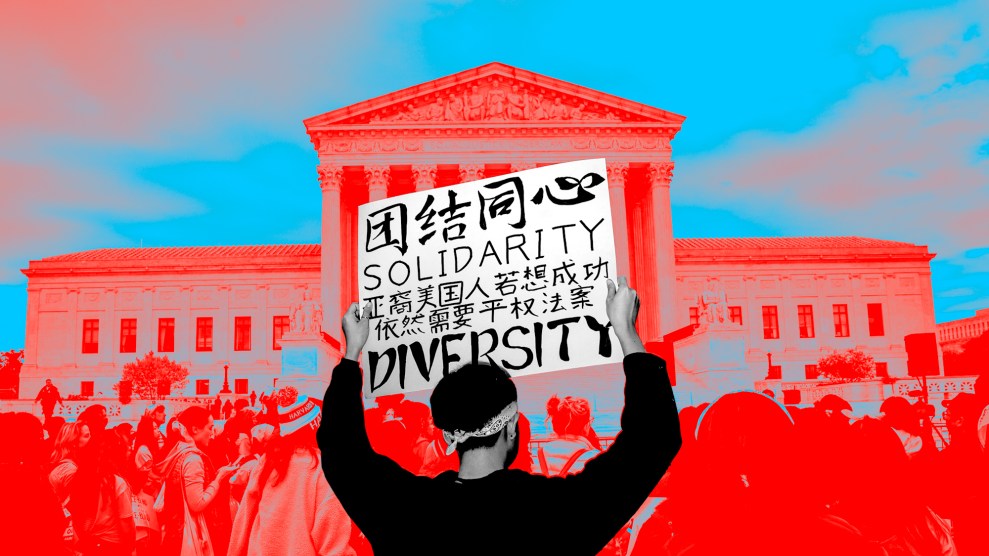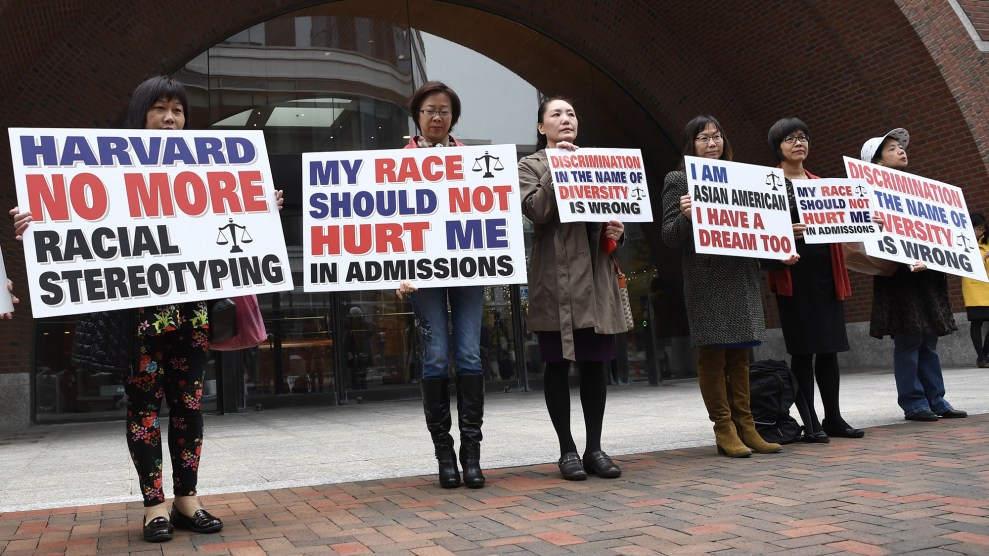
Jabin Botsford/The Washington Post/Getty
The Supreme Court ruled today in a 6-3 decision that the use of race in college admissions violates the equal protection clause of the 14th Amendment and thus is unconstitutional, dealing a serious blow to affirmative action measures used by colleges to create diverse student bodies and remedy past discrimination against minorities.
“Many universities have for too long wrongly concluded that the touchstone of an individual’s identity is not challenges bested, skills built, or lessons learned, but the color of their skin,” Chief Justice John Roberts wrote for the majority. “This Nation’s constitutional history does not tolerate that choice.”
Today’s ruling removes an “irreplaceable tool” for improving higher education, says David Hinojosa of the Lawyers’ Committee for Civil Rights Under Law, who represented a coalition of students and recent graduates backing affirmative action in the North Carolina case. “We know this because every time there’s been a ban on affirmative action, in Michigan, in Oklahoma, in California, in Texas,” he explains, “there have been tremendous drops in racial diversity at the more selective universities.”
“Those state flagships,” Hinojosa adds, “create pathways to leadership that will then be broken and need to be repaired.”
In their filings, the universities had argued that allowing the use of race in admissions had benefits for the school as well as the larger society, and that a diverse student body helped prepare students for a modern workforce. Roberts, who has fought affirmative action since his early days as a young lawyer in the Reagan administration, dismissed those goals as mushy and undefined ideals that would be impervious to judicial review. “While these are commendable goals, they are not sufficiently coherent for purposes of strict scrutiny,” he wrote. “It is unclear how courts are supposed to measure any of these goals, or if they could, to know when they have been reached so that racial preferences can end.”
The decision overturns decades of the court’s own precedent, which was most recently reaffirmed just seven years ago when moderate Justice Anthony Kennedy provided the swing vote to preserve affirmative action in college admissions in Fisher v. University of Texas. In that 2016 decision, the court held that the race-conscious admissions process used by the University of Texas at Austin did not violate the equal protection clause. But Kennedy retired in 2018, and President Donald Trump replaced him with Justice Neil Gorsuch and two other appointees who together formed the voting bloc that tossed out Kennedy’s reasoning.
Typically the Supreme Court only takes up a case when there is a circuit split, which there was not in the affirmative action cases. As they did with the Dobbs decision overturning abortion rights that the court had just reaffirmed in 2016, the newly activist conservative Trump majority took the Students for Fair Admissions v. Harvard and SFFA v. University of North Carolina cases anyway, presumably with the intention of reaching the conclusion it issued today demolishing 40 years’ worth of court jurisprudence that has allowed colleges to use race as one factor in making admissions decisions.
The decisions came in two separate cases brought by SFFA, a conservative group led by Edward Blum, a longtime crusader against affirmative action and voting rights who also was the engine behind the Fisher case. Abigail Fisher, the white plaintiff in that case who the University of Texas rejected because of her mediocre grades, is on the board of Students for Fair Admissions, as is her father.
One case, against the University of North Carolina, challenged the use of race in admissions in public institutions based on a constitutional claim that race-conscious admissions policies violated the equal protection rights of white and Asian applicants who were passed over in favor of other minority applicants. The case against Harvard College challenged the use of race under Title VI of the 1964 Civil Rights Act. In that case, SFFA filed a lawsuit in 2014 arguing that considering race in admissions resulted in discrimination against highly qualified Asian American applicants, who, its lawyers have claimed, were treated much like Jews shut out of the prestigious institution in the 1920s and ’30s. The lawsuit accused Harvard of imposing strict caps on the number of incoming Asian American students while giving preference to Black, Hispanic, and white students who are less qualified.
In 2019, after a three-week federal bench trial, a federal district judge rejected that argument, and the 1st Circuit Court of Appeals upheld the trial court verdict in 2020. In ruling in Harvard’s favor, the trial court judge criticized Blum’s group for failing to produce a single Asian American witness to testify about how they were discriminated against by Harvard. Indeed, in nearly a decade of litigation in the case and full access to Harvard’s admissions files, SFFA has never produced a single Asian American applicant to Harvard who could have or should have been admitted but for the school’s allegedly discriminatory admissions process. That’s no surprise given that while Asians make up about 7 percent of the American population, they account for nearly 30 percent of Harvard’s class of 2027. That lack of identifiably injured parties in the litigation is a major flaw that Harvard’s lawyers have argued should have resulted in the case being tossed out long ago because the plaintiff lacks an injury that would give it standing. In its opinion today, the court said SFFA clearly had standing to bring the case as an organization and dismissed those concerns about the lack of victims.
In a dissent she read from the bench, Justice Sonia Sotomayor denounced the majority decision for contravening the equality envisioned by the 14th Amendment. “Today, this Court stands in the way and rolls back decades of precedent and momentous progress,” she wrote. “In so holding, the Court cements a superficial rule of colorblindness as a constitutional principle in an endemically segregated society where race has always mattered and continues to matter.”
The court’s newest justice, Ketanji Brown Jackson, wrote a separate and equally furious dissent. “With let-them-eat-cake obliviousness, today, the majority pulls the ripcord and announces ‘colorblindness for all’ by legal fiat. But deeming race irrelevant in law does not make it so in life,” she wrote. “And having so detached itself from this country’s actual past and present experiences, the Court has now been lured into interfering with the crucial work that UNC and other institutions of higher learning are doing to solve America’s real-world problems.”
The decision comes at a time of white backlash on the American right against advances toward equality made by people of color. Presidential hopeful and GOP Florida Gov. Ron DeSantis and his ideological allies pushing such initiatives argue that the Constitution is colorblind. He is now hoping to use this agenda as a springboard to the White House.
“The anti-DEI efforts are connected with the anti-affirmative action efforts in the sense that they are trying to erase any notion of systemic discrimination against historically marginalized people of color, including Black people,” says Hinojosa, and our “horrid history of slavery and discrimination and the remnants thereof.”
Enrollment of racial minorities at selective universities will now, as lower courts warned, assuredly fall. The judge in the Harvard case found that “eliminating consideration of race would cause the African American representation at Harvard to decline from approximately 14% to 6%… and Hispanic representation to decline from 14% to 9%,” and notably held that the caliber of students would not improve. Race-neutral programs, the judge further found, would not make up for these losses. In the University North Carolina case, a judge agreed there were no “workable or viable race-neutral alternatives, singularly or in conjunction, that would allow [the university] to achieve the educational benefits of diversity.”













